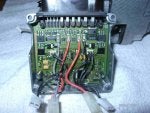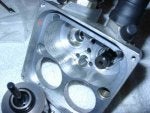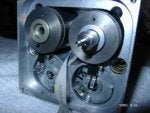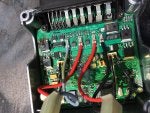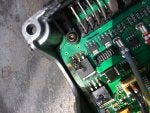hello,
It's always sad to not have any news after spending some time to figure out what could be the issue and how to help with so few information.
Anyway, for those who can be interested, I try to show how the control valve works in these I-ABS units and the dependency between the 2 separate fluid circuits: the one from the brake lever, in blue colour, and the one to the caliper, in yellow colour.
The main acting component is a small ball in front of the Control Piston ( in purple below). This ball split the whole area housing the failsave piston in 2 chambers.
I will explain later what is the role of the failsave piston.
1/ When the system is in standby mode, no brake activated, the gap between the 2 chambers is large and the pressure of the fluid is equal in both side (in yellow).
2/ When the brake is pulled, the blue liquid will move the control piston, thus pushing the purple ball and reducing the gap between the 2 chambers.
At the same time the electric pump will raise up the pressure to the caliper and the green ball (a valve in the outlet port) will prevent the fluid to go back to the reservoir.
Usually, the failsave piston will not move. Only 2 mm of movement of the Control Piston is enough to lock the wheel.
The ABS function is accomplished by the electromagnetic field forcing the Control Piston to move back and forward. This will increase and decrease alternatively the gap between the purple ball and the failsave piston, reducing the pressure and then re-applying the pressure to the caliper.
3/ When the I-ABS unit fails, there is still the possibility to have some kind of brake, called by BMW Residual braking feature and based on the failsave piston (but for me it is a cruel "joke").
The pilot will pull the lever to increase the pressure in the control circuit. The blue fluid will move deeper the control piston, the purple ball will completely close the gap.
Because the electric pump is out of service, the pilot has to increase the pressure at the lever and this will finally move the failsave piston.
This is how the pressure rise up to the brake caliper, in red colour below.
Because we are on a forum and I spend time to write this text and do these pictures I have to add 3 things:
- Sorry for my bad English, I'm quite better in my native language.
- You are free to copy and use these pictures as long as you don't make any money with them. (yes, I'm a dreamer)
- I really hope someone will found some help with this thread
By now, have a good and safe ride.
Cheers,


